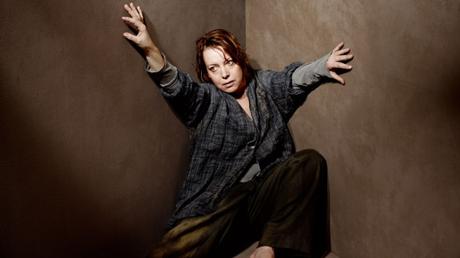 Swedish soprano Nina Stemme as Elektra (Metropolitan Opera)
Swedish soprano Nina Stemme as Elektra (Metropolitan Opera)It’s Greek to Me!
Every generation feels it has the answers to life’s problems — and ours is no exception. When I was growing up in the Sixties, it was easy to blame the prior generation for the many ills we saw around us; to hold those in high office accountable for the endless, unresolved conflicts strewn about the land.
It’s during those trying times that many find comfort in family and friends. While some leave home and hearth to set off on their own volition, others stay put so as to deal with or fend off the difficulties as best they can.
The effect of unending conflicts, with frazzled nerves constantly on the edge of collapse, can only lead to all-out tragedy. And who better to depict those tragedies than the ancient Greeks — or, in their stead, the generation that gave rise to the First World War (or the Great War, as it was once known).
German composer Richard Strauss and his favorite poet, Hugo von Hofmannsthal, were part of that generation. In fact, their supreme collaboration, vide the opera Die Frau ohne Schatten (“The Woman without a Shadow”), paid supportive deference to the family unit as the central focus of a happy home life. In contrast, however, their preceding work, the opera Der Rosenkavalier (“The Cavalier of the Rose”), seemed to mock those sentiments entirely, with humorous jabs at familial relations (for example, the boorish cousin Baron Ochs) amid the amorous exploits and extramarital trysts of the petulant Octavian and the Field Marshal’s wife.

While that may well be the case, most historians and musicologists would agree that the team’s most forceful achievement in the operatic realm were its two earlier efforts: the one-acters Salome (1905), adapted from Oscar Wilde’s scandalous 1893 play Salomé; and Elektra (1909), based on Hofmannsthal’s drama of the same name and on the original treatment given by Greek playwrights Sophocles and Aeschylus.
In an unusual juxtaposition of musical events, the Metropolitan Opera Saturday broadcast of Elektra came on April 30, 2016, near the tail end of the 2015-2016 radio season; while the later transmission of Salome occurred on December 17, 2016, at the start of the 2016-2017 season.
Both operas featured all-star casts, among them Nina Stemme, Adrianne Pieczonka, Susan Neves, Roberta Alexander, Waltraud Meier, Eric Owens, James Courtney, Burkhard Ulrich, and Kevin Short in Elektra, conducted by Esa-Pekka Salonen; and Patricia Racette substituting for the previously announced Catherine Naglestad, Željko Lučić, Gerhard Siegel, Kang Wang, Nancy Fabiola Herrera, and Carolyn Sproule for Salome, presided over by Johannes Debus.
At their respective premieres, both Strauss works came in for heavy criticism for their brutally raw sexuality and exceedingly perverse characterizations (in the Princess Salome and Queen Klytämnestra) as well as the matricidal tendencies of that deadly brother-sister combo of Orest and Elektra.
Greek legends being what they are, the story of Elektra, derived from classical mythology and known as the Mycenaen saga (or Oresteia), was not the first treatment of this daring subject. Gluck’s two back-to-back works in this vein, Iphigénie en Aulis (1774) and Iphigénie en Tauride (1779), both predate and elaborate upon the circumstances involving King Agamemnon’s sacrifice of his daughter Iphigenia, his murder by his wife Clytemnestra and her lover Aegisthus, and Orestes’ slaying of the treacherous pair and subsequent imprisonment. His sister Electra is only mentioned by name.

Mozart’s opera seria Idomeneo, which premiered in Strauss’ hometown of Munich in 1791, included the antagonist Elettra (in the original Italian libretto). As the revenge-filled daughter of Agamemnon, who was the same fellow who fought in the Trojan Wars, Elettra was performed by a coloratura soprano. She is one of the earliest surviving embodiments of this character to appear in a standard repertory piece. Prophetically, Strauss rearranged and re-orchestrated Idomeneo (along with introducing newly composed music of his own) for a 1931 Vienna State Opera production.
Strauss’ lifetime fascination with Greek myth pervaded his musical compositions from his earliest days. We need only mention such examples as the pastiche Ariadne auf Naxos (1912; revised 1916) and its wittily realized clash between the modern and ancient worlds; the dreamlike Die ägyptische Helena (“The Egyptian Helen,” 1928), based on a conceit that the fabled Helen of Troy was kidnapped and whisked away to the Land of the Pharaohs; and the operas Daphne (1938) and Der Liebe der Danae (“The Loves of Danae, 1944), both depicting mythological figures Apollo, Jupiter, Mercury, Midas, and others.
As a representative of the German bourgeoisie, whose smug contentment with the status quo oftentimes clashed with the harsh realities of pre- and post-World War I existence, Strauss had realized themes in his two-hour, powered-packed oeuvre Salome and Elektra that would, in due course, lay the groundwork for the coming decadence of Nazism. The deterioration of morals and ethics so outlandishly brought to the fore by Herod’s court and in the Princess Salome’s sultry Dance of the Seven Veils, not to mention her erotic attraction to Jokanaan’s severed head, were but harbingers of the horrors to come.
Topping even this, the moral depravity that poisoned the atmosphere that Elektra and her sister, Chrysothemis, were forced to survive in — while begging for scraps from the servants and bearing witness to the treachery that led to Agamemnon’s brutal murder at their own mother’s hand — accurately, if not presciently, conveyed the notion that corruption and wickedness began in the home.
The Jagged Edge
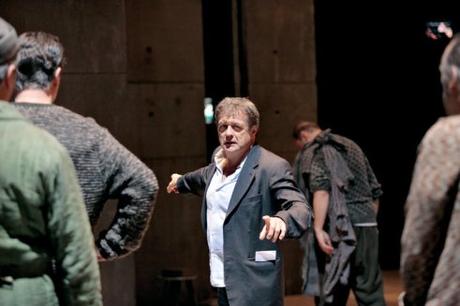
The late and much lamented French director Patrice Chéreau, whose 1976 Bayreuth centennial production of Wagner’s Ring has achieved an almost legendary standing, unveiled his vision for Elektra back in 2013 at the Aix-en-Provence Festival in France. Reviewed in Opera News and in other similarly themed publications, this production made its initial Met Opera impact in April of 2016, a few short years after the director’s untimely passing from lung cancer. It won overwhelmingly positive notices for its emotional content and psychological insight into the souls of its protagonists.
Celebrated for his outstanding work with singers and for his theatrical finesse and acumen, Chéreau was feted for another depiction of tortured, imprisoned souls in the Met’s premier presentation of Leoš Janáček’s From the House of the Dead, in November 2009. Using the same creative team that he did for Elektra (set designer Richard Peduzzi, who worked with the director on the Ring cycle, and costume designer Caroline de Vivaise), Chéreau set the opera in a “bleak, monumental palace” courtyard — similar in shape and scope to the single set found in From the House of the Dead (with that evocative title seeming to cast a subliminal pall over the machinations of the lead characters’ plight).
The opera was staged in New York by Vincent Huguet, Chéreau’s assistant at Aix-en-Provence. Meticulous attention to detail, and to the interpersonal dynamic between characters were the most obvious signs of a well-planned and well-executed affair. Strauss provided this intensely mesmerizing work with music of elemental force. Gripping dissonance and raucous cacophony, from the lowest bass notes to the highest cries in the strings, were the norm. But there are also melodies of such overpowering tenderness that to hear them, as played by the excellent Met Opera Orchestra under the impeccable maestro Esa-Pekka Salonen, was absolutely startling.
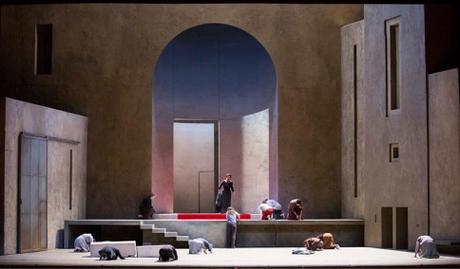
Beginning with the opening chords, the full orchestra blasts forth the name of Agamemnon to wild abandon (a trick Strauss used again at the start of Die Frau ohne Schatten, with the Spirit King Keikobad), then dies down to a barely audible rumbling in the Wagner tubas and bass clarinet. Jagged leaps up and down the scale, two and three octave jumps, sliding trombones, violins screeching and whining like the howling of the wind, bold bursts of violent sound coming from the brass section: all these, and singing, too! The opera ends as it began, with a repeat of the D minor intonation of Agamemnon’s name, followed by deathly silence.
It took the Metropolitan an entire generation to present this piece. At the time, Elektra’s so-called immorality and overt hints of incestuous bisexuality were deemed “too sensational” for Met audiences. The opera’s debut finally came in 1932, with Arthur Bodansky conducting and Gertrude Kappel in the title role. Fritz Reiner led the Swedish-born Astrid Varnay in the 1950s, while Inge Borkh essayed the part in the early 1960s. Hailed as a conductor’s piece, the opera has been presided over by the likes of Dimitri Mitropoulos, Arthur Rodzinsky, Thomas Beecham, Eugen Jochum, Karl Böhm, Erich Leinsdorf, Herbert von Karajan, Carlos Kleiber, Georg Solti, and James Levine.
Singers’ Roundtable
Elektra is one of the most demanding roles in all opera, with a range of two octaves (and then some) going from middle C to high C. And few singers could match the high-voltage decibel levels of the inimitable Birgit Nilsson, although German soprano Hildegard Behrens’ dramatic sensibilities were not lost on Met Opera audiences. Other great interpreters of Elektra included sopranos Rose Pauly, Erna Schlüter, Anny Konetzni, Gwyneth Jones, and now Nina Stemme.
Initially, director Chéreau had chosen Evelyn Herlitzius as his Elektra at Aix. Canadian soprano Adrianne Pieczonka repeated her assignment as Chrysothemis at both Aix and the Met. As mentioned above, the spacious setting was more in line with that of a madhouse than a royal palace at Mycenae. The curtain rises before any music is heard. Serving women come out on stage and begin their daily tasks. It’s only at this point that Elektra is let out from her cell that the opera proper begins. She has the wild look of like a caged animal, of someone who has spent her adult years in solitary confinement.
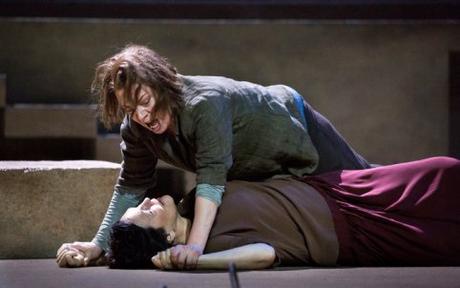
Swedish dramatic soprano Nina Stemme, with her large, soul-searching eyes and searing intensity, penetrated the massive orchestration with an emotionally charged, devastatingly credible interpretation of Elektra. From the big moments in her opening monologue, “Allein! Weh, ganz allein!” to her frozen, immobile form at the opera’s conclusion, Stemme captured the character’s inability to act out her revenge with a wrenching poignancy only a handful of great artists could begin to suggest. In this, and in many other senses, Elektra is Shakespeare’s Hamlet; the vengeance ploy is itself the very be-all and end-all of both stories. And Stemme was the right singer in the right spot to do full justice to the part.
As Chrysothemis (the sisters’ other sibling, Iphigenia, you’ll remember, was sacrificed to the gods in order that their father Agamemnon’s ships could have favorable winds in his ships’ sails), Pieczonka exemplified the caring yet pleading aspects of a family member who knows that Elektra needs much more aid and comfort than she alone can provide. Their scenes of sisterly “affection,” for lack of better term, were sung with a clear line and easily distinguishable timbre by the two female leads. Desperation kicked in as Chrysothemis was loath to assist her sister in carrying out their mother’s massacre.
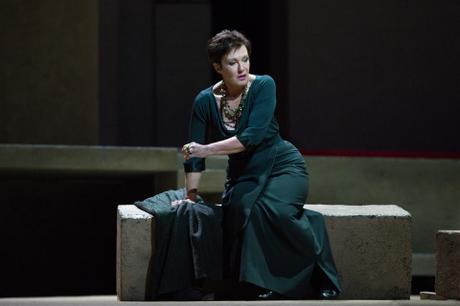
Speaking of which, the one inventive element of this production was the manner in which Klytämnestra was portrayed. Normally, one expects a cackling, over-stimulated, hysterical harpy, an individual wracked with guilt and painfully overburdened with having to deal with the uncooperative and intractable Elektra. Heck, this is one dysfunctional family member! Mezzo Waltraud Meier, who in the past has undertaken such varied assignments as Wagner’s Isolde Brünnhilde, and Kundry, Berg’s Marie in Wozzeck, as well as Verdi’s Princess Eboli in Don Carlo, was definitely NOT your grandfather’s Klytämnestra. Hers was a more (how shall one put it?) “humane” reading of this ignoble creature, and a valid one to boot.
Past adherents of the part — I’m thinking of Met stalwart Regina Resnik, a superb singing actress and fellow James Monroe High School alumnus, along with Martha Mödl, another famed exponent of Brünnhilde and Isolde who turned to mezzo roles in her later years — have uniformly depicted Elektra’s mom as an incorrigible virago. What Meier provided was beautiful tone and an unmistakable air of murky eventuality, along with justification for her and her paramour’s violent act against the paterfamilias.
Bass-baritone Eric Owens as the avenging Orest (the German form of Orestes), whose distinctive timbre and careful enunciation of the text (via permanently clenched-teeth) has made him a frequently called-upon Alberich and Porgy, gave a more subdued portrait than expected. Again, in Chéreau’s carefully wrought analysis, Orest is an even more reluctant participant than the norm. Don’t forget: his principle modus operandi is to seek retribution for his mother’s heinous act. Owens’ silence and stillness, in this instance, spoke wordless volumes.

Elektra (Stemme) embraces her brother Orest (Eric Owens) in the Recognition Scene (Metropolitan Opera)
" data-orig-size="4050,2700" sizes="(max-width: 470px) 100vw, 470px" data-image-title="Great Performances at the Mt: Elektra" data-orig-file="https://josmarlopes.files.wordpress.com/2017/02/elektra-and-orest-recognition-scene.jpg" data-image-meta="{"aperture":"2.8","credit":"Marty Sohl\/Metropolitan Opera","camera":"Canon EOS 5D Mark III","caption":"Nina Stemme in the title role and Eric Owens as Orest in Richard Strauss's \"Elektra\". Photo: Marty Sohl\/Metropolitan Opera.","created_timestamp":"1459961065","copyright":"Marty Sohl\/Metropolitan Opera","focal_length":"300","iso":"4000","shutter_speed":"0.00625","title":"Great Performances at the Mt: Elektra","orientation":"1"}" width="470" data-medium-file="https://josmarlopes.files.wordpress.com/2017/02/elektra-and-orest-recognition-scene.jpg?w=470&h;=313" data-permalink="https://josmarlopes.wordpress.com/2017/02/12/dysfunctional-family-values-elektra-and-salome-at-the-met-part-one/great-performances-at-the-mt-elektra/" alt="Nina Stemme in the title role and Eric Owens as Orest in Richard Strauss's "Elektra". Photo: Marty Sohl/Metropolitan Opera." height="313" srcset="https://josmarlopes.files.wordpress.com/2017/02/elektra-and-orest-recognition-scene.jpg?w=470&h;=313 470w, https://josmarlopes.files.wordpress.com/2017/02/elektra-and-orest-recognition-scene.jpg?w=940&h;=626 940w, https://josmarlopes.files.wordpress.com/2017/02/elektra-and-orest-recognition-scene.jpg?w=150&h;=100 150w, https://josmarlopes.files.wordpress.com/2017/02/elektra-and-orest-recognition-scene.jpg?w=300&h;=200 300w, https://josmarlopes.files.wordpress.com/2017/02/elektra-and-orest-recognition-scene.jpg?w=768&h;=512 768w" class=" wp-image-6187" data-large-file="https://josmarlopes.files.wordpress.com/2017/02/elektra-and-orest-recognition-scene.jpg?w=705" />Elektra (Nina Stemme) embraces her brother Orest (Eric Owens) in Strauss’s Elektra (Photo: Marty Sohl/Metropolitan Opera)However, the drama’s apex occurs past the midway point, in the duly famous “Recognition Scene,” where, moments before, Klytämnestra is told that a messenger has arrived bearing news of Orest’s death. That messenger is Orest in disguise. In this production, the Old Servant (wonderfully enacted by veteran James Courtney) and Orest’s guardian (bass Kevin Short) are given added prominence. Just as Elektra has realized that the stranger before her is indeed her beloved Brüder (with a brilliant shout of “Orest!” above another of those orchestral outbursts), the two old men come together in a warm embrace. Interestingly, at the Aix-en-Provence performance, these two characters were enacted by Donald McIntyre and Franz Mazura, two war-weary veterans of Chéreau’s Bayreuth Ring — a thoroughly delightful happenstance.
We must put in a plug for another veteran artist, soprano Roberta Alexander, as the Fifth Maidservant, whose lustrous vocal display at the beginning of the piece was praised and commented upon in both the Aix-en-Provence and Met Opera productions.
On an historical side note, the monumental irony of Strauss’ later years has been documented in Alex Ross’ richly researched tome, The Rest is Noise: Listening to the Twentieth Century. Ross tells how the once renowned composer, who publicly supported Hitler and his Nazi Party, yet privately railed against them, was found by occupation forces at his villa in Garmisch; how a sign just outside the entranceway, indicating that the house where the famous composer Richard Strauss lived as declared “Off Limits”; how, like Orest, Strauss’ face became almost unrecognizable, until an music-loving American officer was able to vouch for the composer and rescued him from possible imprisonment (or worse).
A punishment for past misdeeds? Divine intervention or retribution? A Greek tragedy come to life? Who can say? Strauss had stayed in Germany when all signs pointed to his getting out. In Ross’ account, “if he had left by himself, his extended family [and his Jewish daughter-in-law] would presumably have been sent to the concentration camps. Strauss had little choice but to undergo a humiliating process of self-rehabilitation” (Ross, p. 325).
If only others were that lucky.
(End of Part One)
To be continued…
Copyright © 2017 by Josmar F. Lopes

